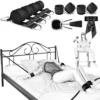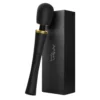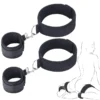Suspension Bondage Gears
- What Is Suspension Bondage?
- Types of Suspension Bondage: Techniques and Positions
- Essential Suspension Bondage Gear: How to Choose
- Step-by-Step: How to Perform Suspension Bondage Safely
- Pros and Cons of Suspension Bondage
- Safety First: Non-Negotiable Guidelines
- Conclusion: Elevating Intimacy Through Mastery
- Suspension Bondage Gears FAQs
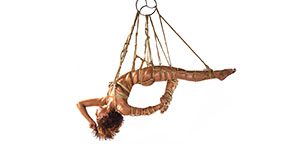
BDSM
Explore the world of BDSM, a realm of diverse practices like bondage, discipline, sadism, and masochism. Learn about its toys, safety guidelines, and how to engage consensually for an enriching and thrilling experience.
Suspension bondage, an advanced and visually striking practice within BDSM, combines artistry, trust, and technical skill to create an exhilarating experience for both dominants (“tops”) and submissives (“bottoms”). While its erotic appeal is undeniable, suspension bondage demands meticulous preparation, expertise, and a focus on safety to avoid injury. This guide delves into the essentials of suspension bondage, its types, gear selection, safety protocols, and how to navigate this intense form of power exchange responsibly.

What Is Suspension Bondage?
Suspension bondage involves suspending a person (the “bottom”) in mid-air using ropes, chains, or specialized hardware attached to overhead anchor points. The “top” orchestrates the suspension, tying intricate patterns or securing restraints to evoke physical and psychological stimulation. This practice amplifies the bottom’s vulnerability, as movement is restricted and escape attempts could lead to harm. Beyond physical restraint, it fosters deep trust, intimacy, and a shared adrenaline rush, making it a cornerstone of advanced BDSM play.

Types of Suspension Bondage: Techniques and Positions
Suspension bondage offers diverse styles to match skill levels and desires. Below are key categories:
1. By Weight Support
- Partial Suspension:
- The bottom’s weight is partially supported by the ground (e.g., one foot anchored) while ropes or cuffs elevate other body parts.
- Ideal for beginners or prolonged sessions, reducing strain on joints and circulation.
- Full Suspension:
- The bottom is entirely suspended off the ground, relying solely on bondage gear for support.
- Requires advanced skill and robust equipment to distribute weight safely.
2. By Body Position
- Vertical Suspension:
- The bottom hangs upright, often secured by wrists, a chest harness, or a hip harness.
- Common tools: Suspension cuffs, rigid ropes, or metal rings.
- Horizontal Suspension:
- The body lies parallel to the ground, face-up or face-down, anchored by ankles, wrists, or a full-body harness.
- Creates a “floating” aesthetic and allows for full-body accessibility.
- Inverted Suspension:
- The bottom hangs upside-down, typically by ankles or a specialized harness.
- Caution: Limits blood flow to the head; sessions should be brief (5–10 minutes max).
3. By Aesthetic Style
- Shibari/Kinbaku (Japanese Style):
- Emphasizes intricate, decorative rope patterns that blend artistry with restraint.
- Uses natural-fiber ropes (jute, hemp) for friction and grip.
- Western-Style Bondage:
- Focuses on practicality and restraint, often using cuffs, chains, or synthetic ropes.
- Prioritizes quick setup and ease of adjustment.
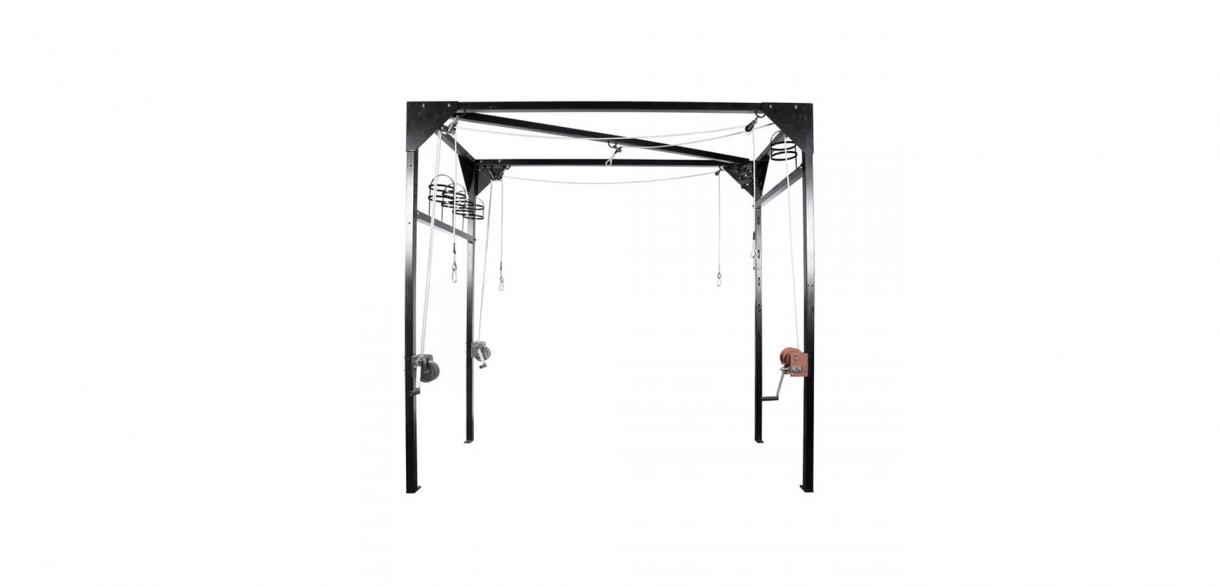
Essential Suspension Bondage Gear: How to Choose
Selecting the right equipment is critical for safety and satisfaction. Consider these factors:
1. Suspension Materials
- Ropes:
- Natural Fibers (jute, hemp): Ideal for Shibari—durable, grippy, and aesthetically pleasing.
- Synthetic Ropes (nylon, MFP): Softer on skin, easier to clean, but may slip.
- Avoid: Paracord or cotton—stretches under weight, increasing fall risk.
- Hardware:
- Carabiners: Opt for load-rated climbing-grade metal (e.g., 3,000+ lbs capacity).
- Suspension Cuffs: Leather or padded neoprene cuffs reduce nerve pressure.
- Rigging Plates/Mounts: Ceiling anchors must support dynamic weight (consult a structural engineer).
2. Safety and Durability
- Weight Capacity: Gear should exceed the bottom’s weight by 5–10x.
- Inspect Regularly: Check ropes for fraying, hardware for corrosion, and anchors for stability.
- Quick-Release Mechanisms: Include safety shears or panic snaps for emergencies.
3. Comfort and Skill Level
- Beginners: Start with partial suspension using wide, padded cuffs and pre-tied harnesses.
- Advanced Users: Experiment with full suspension, inverted poses, or multi-point rigging.
Step-by-Step: How to Perform Suspension Bondage Safely
1. Preparation:
- Anchor Points: Confirm ceiling mounts or frames can handle dynamic loads (e.g., swinging).
- First Aid Kit: Keep nearby, along with emergency contact info.
- Consent & Limits: Discuss pain thresholds, medical conditions (e.g., joint issues), and safewords.
2. Tying Techniques:
- Single-Column Tie: Secure limbs with non-slip knots (e.g., Somerville Bowline).
- Chest Harness: Distribute weight across the torso using a diamond or Takate Kote pattern.
- Load Distribution: Avoid placing ropes over joints (wrists, knees) to prevent nerve damage.
3. During Suspension:
- Monitor Circulation: Check for numbness, tingling, or discoloration in extremities every 5–10 minutes.
- Adjust Gradually: Raise/lower the bottom slowly to avoid sudden strain.
4. Aftercare:
- Gentle Lowering: Support the bottom’s weight as they touch the ground.
- Physical Care: Massage restrained areas, hydrate, and apply warm compresses to sore muscles.
- Emotional Check-In: Debrief the experience to address any trauma or anxiety.
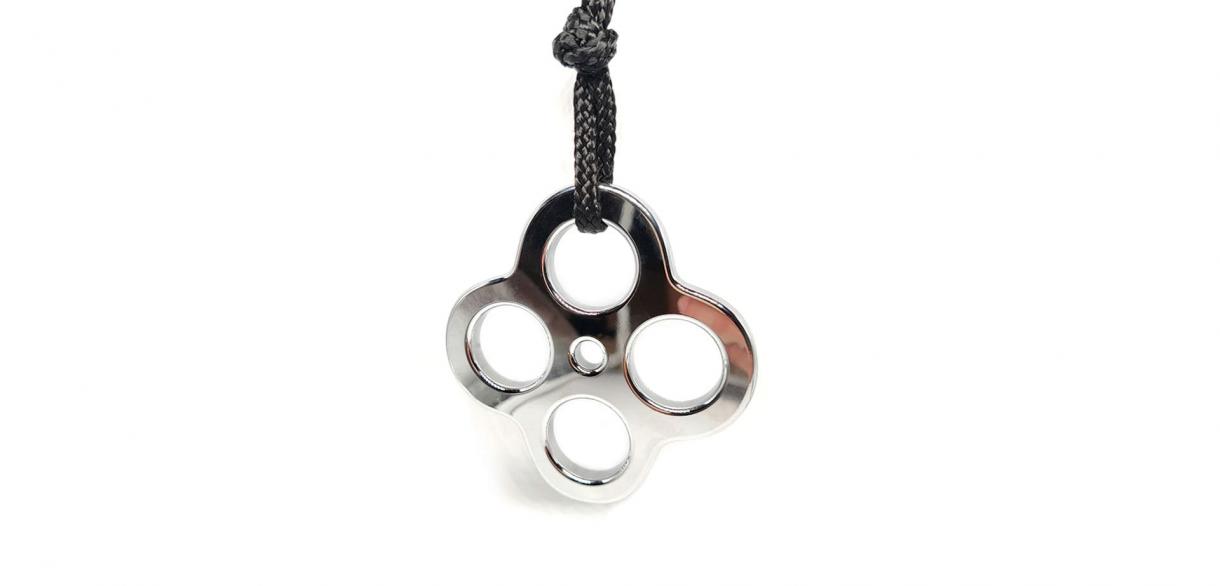
Pros and Cons of Suspension Bondage
Advantages
- Deepened Trust: Requires unparalleled communication and cooperation.
- Artistic Expression: Shibari’s intricate patterns are visually stunning and meditative to tie.
- Sensory Intensity: Combines adrenaline, vulnerability, and physical stimulation.
- Cost-Effective: High-quality ropes and hardware can be reused across sessions.
Risks and Challenges
- Injury Potential: Falls, nerve damage, or circulation loss if done improperly.
- Skill Demands: Mastery takes months/years of practice; beginners should seek mentorship.
- Legal Considerations: Improper anchor installation may violate building codes.
Safety First: Non-Negotiable Guidelines
- Never Suspend Alone: Always have a spotter or experienced rigger present.
- Avoid Alcohol/Drugs: Impairment increases accident risks.
- Educate Yourself: Attend workshops or study resources like The Little Guide to Getting Tied Up.
- Start Low, Go Slow: Begin with partial suspensions inches off the ground before progressing.

Conclusion: Elevating Intimacy Through Mastery
Suspension bondage is more than a Velumira—it’s a fusion of engineering, anatomy, and emotional connection. Whether drawn to the elegance of Shibari or the raw power of Western restraint, success hinges on education, preparation, and respect for limits. Invest in premium gear, prioritize safety, and embrace the journey of learning. With patience and care, suspension bondage can unlock transcendent levels of trust and pleasure for all involved.
Explore our curated selection of suspension bondage kits and begin your journey into the skies of sensation—responsibly, passionately, and safely. 🔗✨

BDSM
Explore the world of BDSM, a realm of diverse practices like bondage, discipline, sadism, and masochism. Learn about its toys, safety guidelines, and how to engage consensually for an enriching and thrilling experience.
Suspension Bondage Gears FAQs
What type of ropes should I use for rope bondage suspension?
For rope bondage suspension, it is important to use high – quality, strong, and comfortable ropes. Natural fiber ropes, such as jute or hemp, are popular choices for their durability, texture, and ability to hold knots securely. Synthetic ropes like nylon or MFP (multifilament polypropylene) can also be used, as they are easy to clean, maintain, and have a smooth texture. Always inspect your ropes for any signs of wear or damage before use to ensure a safe suspension experience.
What are some essential suspension bondage gear items for beginners?
When starting with suspension bondage, it is crucial to invest in high – quality, reliable gear. Some essential items for beginners include: comfortable and secure bondage suspension cuffs or wrist suspension bondage restraints, strong rope or webbing, carabiners, and a suspension bar or sturdy anchor point. Safety equipment, such as a pair of EMT shears for quickly cutting ropes in case of an emergency, should also be readily available.
Is suspension bondage safe for everyone?
Suspension bondage can be risky and is not suitable for everyone. Individuals with certain medical conditions, such as heart problems, high blood pressure, or joint issues, should avoid suspension bondage. Additionally, pregnant individuals or those with compromised immune systems should exercise caution. It’s important to discuss any health concerns with a knowledgeable partner or professional and always prioritize safety when engaging in suspension BDSM activities.
How can I ensure safety during a bondage suspension scene?
Safety is of utmost importance during a bondage suspension scene. To maintain a safe environment, always use high – quality and reliable suspension bondage equipment, inspect your gear before each use, and have a clear communication plan with your partner, including the use of safewords. Additionally, educate yourself on proper techniques, weight distribution, and pressure points to minimize the risk of injury. Regularly monitor the suspended person for any signs of discomfort or distress and be prepared to lower them safely if needed.
Are there any tutorials or classes available for learning suspension bondage techniques?
Yes, there are various resources available for learning suspension bondage techniques, including online tutorials, workshops, and classes. Some experienced BDSM practitioners and rope experts offer instructional videos or conduct in – person workshops, providing hands – on guidance and demonstrations. Attending local BDSM events or joining online forums and communities can also be a great way to connect with experienced practitioners and learn from their knowledge.
What is the purpose of a BDSM suspension bar?
A BDSM suspension bar is a piece of equipment designed to provide a secure anchor point for suspension bondage scenes. Suspension bars are often made of sturdy materials like metal or wood and may have multiple attachment points for ropes, cuffs, or other restraints. Using a suspension bar allows for greater control over the positioning and distribution of the suspended person’s weight, helping to ensure a safe and comfortable experience.
How do I choose the right bondage suspension cuffs?
When selecting bondage suspension cuffs, prioritize comfort, durability, and safety. Look for cuffs made from high – quality materials, such as leather, neoprene, or heavy – duty nylon, with padding for added comfort. Ensure the cuffs have strong, secure attachment points and adjustable sizing to accommodate different wrist or ankle sizes. Read product reviews and consider recommendations from experienced practitioners to find the best suspension bondage cuffs for your needs.
Can I perform horizontal suspension bondage?
Yes, horizontal suspension bondage is a variation of suspension bondage in which the person is suspended parallel to the ground. This position can be achieved using ropes, straps, or other types of restraints, and may require additional support points or rigging techniques to ensure even weight distribution and stability. As with any form of suspension bondage, proper technique, safety precautions, and communication with your partner are crucial for a successful and enjoyable experience.
Is latex suspension bondage a different type of suspension bondage?
Latex suspension bondage is a variation of suspension bondage that incorporates latex clothing or restraints. The use of latex adds an additional sensory element and visual appeal to the bondage scene. While the principles and safety precautions for suspension bondage remain the same, using latex materials may require additional care, such as using talcum powder or a lubricant to prevent sticking and ensuring proper fitting to avoid circulation issues.
Can I practice male suspension bondage or inverted suspension bondage?
Male suspension bondage and inverted suspension bondage are both possible variations of suspension bondage. Regardless of gender, the key principles of safety, communication, and proper technique apply. Inverted suspension bondage, where the person is suspended upside down, can be more physically demanding and risky due to increased blood flow to the head. It is essential to monitor the suspended person closely for any signs of distress and to have a plan in place for safely lowering them if needed.
What are some common mistakes to avoid in suspension bondage?
Some common mistakes to avoid in suspension bondage include using low – quality or damaged equipment, tying knots too tight or too loose, ignoring safety precautions, and not communicating with your partner. Additionally, attempting advanced suspension techniques without proper training or experience can lead to injury or an unsatisfactory experience. Always prioritize safety, education, and open communication to ensure a fulfilling and enjoyable suspension bondage scene.
Leave a Reply



